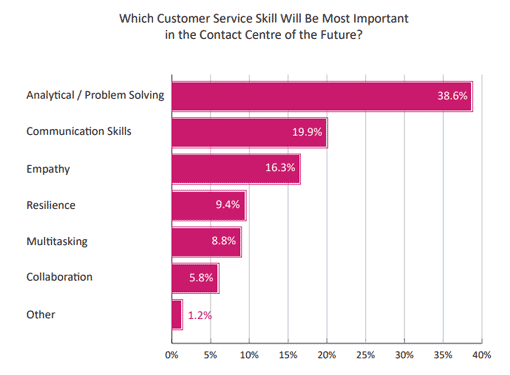We present the latest findings on customer service skills: the job of a contact centre advisor is getting tougher and tougher.
The Key Skill: Problem-Solving and Analysis
Communication skills, empathy and resilience are all critical elements within the arsenal of a contact centre advisor. However, one vital skill sits head and shoulders above the rest in terms of its importance to the future contact centre. That skill is problem-solving.
Just consider the chart below, taken from our latest industry report. For a significant percentage of contact centres, the ability to be analytical and problem-solve is paramount to their future success.

Discover more insights and charts like this in our report: “What Contact Centres Are Doing Right Now (2021 Edition)”.
From these results, contact centre managers seem to predict that advisors will continue to face more challenging contacts as time goes on. These will require the team to delve deeper and find new resolutions.
Maybe such a conclusion seems like a little bit of a stretch. After all, this is just one poll. However, the growth of self-service supports this vision of the future contact centre.
The Undeniable Impact of Self-Service
Many contact centres are delighted by the value that self-service is delivering within customer experiences.
According to our groundbreaking report, 36.2% of industry professionals believe that self-service is the best contact centre technology for delivering maximum value for money.
On top of this, 62.2% view self-service as a critical growth channel for customer experience and, perhaps most significantly, 13.5% identify adding self-service as their primary goal for 2022.
These figures indicate that technology will gobble up more and more of the simple, transactional contacts across the industry.
Good news for contact centres looking to simplify customer experiences and lower contact volumes. It is, however, unfortunate for advisors. Far less often will they get to solve straightforward queries and use them as a “breather”. The intensity of the role will crank up, little by little.
So, what are contact centres doing to turn the tide and better support advisors as they support customers?
Advisor Support Initiatives
62.9% of contact centres now buddy up their advisors. Despite this being an older practice, more operations are doing this, as only 58.2% did so two years ago.
Many more technologies are also coming to the fore that aim to better equip advisors to handle complex customer queries.
Our report also found that advisor empowerment initiatives – which aim to give advisors more control over when, how and where they work – were also much higher than in 2018.
Both buddying and empowering advisors will support their development. Most of the other initiatives that are growing in popularity aim to improve workforce management (WFM).
While bolstering WFM will not simplify the advisor role, it will no doubt boost engagement. In doing so, advisor perseverance will likely increase, which will prove helpful in dealing with a stream of difficult contacts.
However, contact centres are not implementing these initiatives and parking the bus. Many more technologies are also coming to the fore, with the aim of better equipping advisors to handle complex customer queries.
Advisor Support Technologies
Supportive technologies that improve the advisor experience are entering the contact centre at an accelerating speed. Smart desktops, performance management software and knowledge-sharing tools are becoming an ever-present feature within many operations.
Increasingly, these are laced with AI, while other AI technologies, such as process automation and agent-assist, are also featuring more often in contact centres.
In fact, almost 40% of contact centres have now implemented process automation technologies, while over a third have installed virtual assistants – as per our latest industry research. Such a trend is promising, as these tools are specifically designed to simplify the advisor role.
As these systems grow in ingenuity, getting the right balance of these technologies and human intuition is going to become a greater topic of debate within the industry.
Perhaps this is no great surprise. After all, it has been a long time since Albert Einstein once allegedly said:
Computers are incredibly fast, accurate and stupid; humans are incredibly slow, inaccurate and brilliant. Together, they are powerful beyond imagination.
Albert Einstein (allegedly)
Such quotes and the nature of the latest AI technologies make doomsday prophecies of the contact centre at this point seem questionable.
As Nicola Millard, the Principal Innovations Partner at BT, says: “Even if we move from big, physical spaces to a virtual network of experts, those experts will not be wiped out by technology and AI.”
In making this statement, Nicola shares her vision of the future contact centre advisor. In doing so, she identifies five types of “super-agent”. These are:
- Sally the “Swiss Army knife” advisor – She picks up where self-service and automation fails.
- Paula the problem solver – She is sticking the fork into the spaghetti of back-end processes on behalf of the customer.
- Natalie the negotiator – She deals with matters of the high-level escalations team.
- Tony the techie – He knows the contact centre systems and can help to explain automated outcomes.
- Chris the crowdsourced advisor – He is in the cloud and has specific skills that the contact centre can access as and when required.
Each advisor may also train bots and connect with customers through a sophisticated, predictive routing strategy.
Yet a reality such as this is well in the future for the vast majority. First and foremost, contact centres must get to grips with current blockers that prevent advisors from performing to their full potential. Knowledge base failures are a classic example…
Latest Survey Report
These findings come from the latest survey report “What Contact Centres Are Doing Right Now 2021 Edition”. It features over 40 insights into contact centres. Click here to download the latest survey report.
The results for the survey were collected in July and August 2021, and we are delighted to publish this report in partnership with Akixi, NICE, Nuance, Odigo, Poly and ProcedureFlow.
Source: Call Centre Helper Survey: What Contact Centres Are Doing Right Now (2021 Edition) Sample size – 224 Date: August 2021
Author: Robyn Coppell
Published On: 20th Oct 2021 - Last modified: 25th Apr 2024
Read more about - Contact Centre Research, Akixi, Benchmarking, NiCE, Nicola Millard, Nuance, Odigo, Poly, ProcedureFlow, Research





































